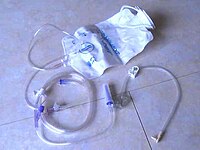
Photo from wikipedia
CONTEXT Despite frequency of gastrostomy placement procedures in children, there remains considerable variability in preoperative work-up and procedural technique of gastrostomy placement and a paucity of literature regarding patient-centric outcomes.… Click to show full abstract
CONTEXT Despite frequency of gastrostomy placement procedures in children, there remains considerable variability in preoperative work-up and procedural technique of gastrostomy placement and a paucity of literature regarding patient-centric outcomes. OBJECTIVES This review summarizes existing literature and provides consensus-driven guidelines for patients throughout the enteral access decision-making process. DATA SOURCES PubMed, Google Scholar, Medline, and Scopus. STUDY SELECTION Included studies were identified through a combination of the search terms "gastrostomy," "g-tube," and "tube feeding" in children. DATA EXTRACTION Relevant data, level of evidence, and risk of bias were extracted from included articles to guide formulation of consensus summaries of the evidence. Meta-analysis was conducted when data afforded a quantitative analysis. EVIDENCE REVIEW Four themes were explored: preoperative nasogastric feeding tube trials, decision-making surrounding enteral access, the role of preoperative imaging, and gastrostomy insertion techniques. Guidelines were generated after evidence review with multidisciplinary stakeholder involvement adhering to GRADE methodology. RESULTS Nearly 900 publications were reviewed, with 58 influencing final recommendations. In total, 17 recommendations are provided, including: (1) tTrial of home nasogastric feeding is safe and should be strongly considered before gastrostomy placement, especially for patients who are likely to learn to eat by mouth; (2) rRoutine contrast studies are not indicated before gastrostomy placement; and (3) lLaparoscopic placement is associated with the best safety profile. LIMITATIONS Recommendations were generated almost exclusively from observational studies and expert opinion, with few studies describing direct comparisons between GT placement and prolonged nasogastric feeding tube trial. CONCLUSIONS Additional patient- and family-centric evidence is needed to understand critical aspects of decision-making surrounding surgically placed enteral access devices for children.
Journal Title: Pediatrics
Year Published: 2022
Link to full text (if available)
Share on Social Media: Sign Up to like & get
recommendations!